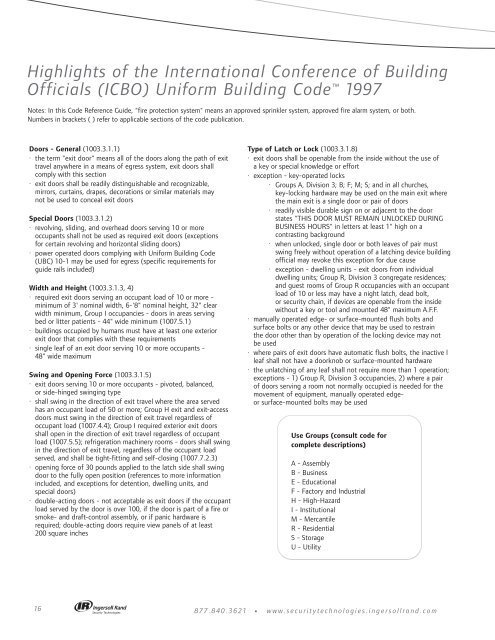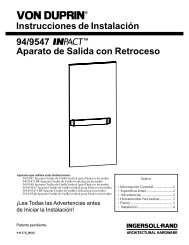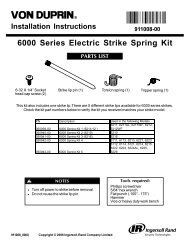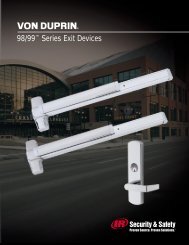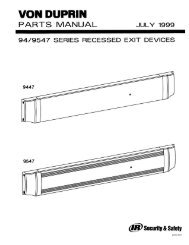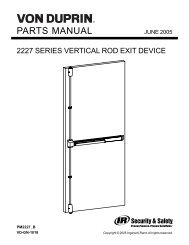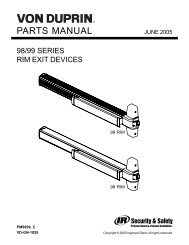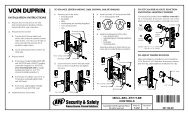Fire, Life Safety & Accessibility Codes - Von Duprin
Fire, Life Safety & Accessibility Codes - Von Duprin
Fire, Life Safety & Accessibility Codes - Von Duprin
Create successful ePaper yourself
Turn your PDF publications into a flip-book with our unique Google optimized e-Paper software.
Highlights of the International Conference of Building<br />
Officials (ICBO) Uniform Building Code 1997<br />
Notes: In this Code Reference Guide, "fire protection system" means an approved sprinkler system, approved fire alarm system, or both.<br />
Numbersinbrackets()refertoapplicable sections of the code publication.<br />
Doors - General (1003.3.1.1)<br />
· the term "exit door" means all of the doors along the path of exit<br />
travel anywhere in a means of egress system, exit doors shall<br />
comply with this section<br />
· exit doors shall be readily distinguishable and recognizable,<br />
mirrors, curtains, drapes, decorations or similar materials may<br />
not be used to conceal exit doors<br />
Special Doors (1003.3.1.2)<br />
· revolving, sliding, and overhead doors serving 10 or more<br />
occupants shall not be used as required exit doors (exceptions<br />
for certain revolving and horizontal sliding doors)<br />
· power operated doors complying with Uniform Building Code<br />
(UBC) 10-1 may be used for egress (specific requirements for<br />
guide rails included)<br />
Width and Height (1003.3.1.3, 4)<br />
· required exit doors serving an occupant load of 10 or more -<br />
minimum of 3' nominal width, 6-'8" nominal height, 32" clear<br />
width minimum, Group I occupancies - doors in areas serving<br />
bed or litter patients - 44" wide minimum (1007.5.1)<br />
· buildings occupied by humans must have at least one exterior<br />
exit door that complies with these requirements<br />
· single leaf of an exit door serving 10 or more occupants -<br />
48" wide maximum<br />
Swing and Opening Force (1003.3.1.5)<br />
· exit doors serving 10 or more occupants - pivoted, balanced,<br />
or side-hinged swinging type<br />
· shall swing in the direction of exit travel where the area served<br />
has an occupant load of 50 or more; Group H exit and exit-access<br />
doors must swing in the direction of exit travel regardless of<br />
occupant load (1007.4.4); Group I required exterior exit doors<br />
shall open in the direction of exit travel regardless of occupant<br />
load (1007.5.5); refrigeration machinery rooms - doors shall swing<br />
in the direction of exit travel, regardless of the occupant load<br />
served, and shall be tight-fitting and self-closing (1007.7.2.3)<br />
· opening force of 30 pounds applied to the latch side shall swing<br />
door to the fully open position (references to more information<br />
included, and exceptions for detention, dwelling units, and<br />
special doors)<br />
· double-acting doors - not acceptable as exit doors if the occupant<br />
load served by the door is over 100, if the door is part of a fire or<br />
smoke- and draft-control assembly, or if panic hardware is<br />
required; double-acting doors require view panels of at least<br />
200 square inches<br />
Type of Latch or Lock (1003.3.1.8)<br />
· exit doors shall be openable from the inside without the use of<br />
a key or special knowledge or effort<br />
· exception - key-operated locks<br />
· Groups A, Division 3; B; F; M; S; and in all churches,<br />
key-locking hardware may be used on the main exit where<br />
the main exit is a single door or pair of doors<br />
· readily visible durable sign on or adjacent to the door<br />
states "THIS DOOR MUST REMAIN UNLOCKED DURING<br />
BUSINESS HOURS" in letters at least 1" high on a<br />
contrasting background<br />
· when unlocked, single door or both leaves of pair must<br />
swing freely without operation of a latching device building<br />
official may revoke this exception for due cause<br />
· exception - dwelling units - exit doors from individual<br />
dwelling units; Group R, Division 3 congregate residences;<br />
and guest rooms of Group R occupancies with an occupant<br />
load of 10 or less may have a night latch, dead bolt,<br />
or security chain, if devices are openable from the inside<br />
without a key or tool and mounted 48" maximum A.F.F.<br />
· manually operated edge- or surface-mounted flush bolts and<br />
surface bolts or any other device that may be used to restrain<br />
the door other than by operation of the locking device may not<br />
be used<br />
· where pairs of exit doors have automatic flush bolts, the inactive l<br />
leaf shall not have a doorknob or surface-mounted hardware<br />
· the unlatching of any leaf shall not require more than 1 operation;<br />
exceptions - 1) Group R, Division 3 occupancies, 2) where a pair<br />
of doors serving a room not normally occupied is needed for the<br />
movement of equipment, manually operated edgeor<br />
surface-mounted bolts may be used<br />
Use Groups (consult code for<br />
complete descriptions)<br />
A - Assembly<br />
B - Business<br />
E - Educational<br />
F - Factory and Industrial<br />
H - High-Hazard<br />
I - Institutional<br />
M - Mercantile<br />
R - Residential<br />
S - Storage<br />
U - Utility<br />
16 877.840.3621 • www.securitytechnologies.ingersollrand.com


